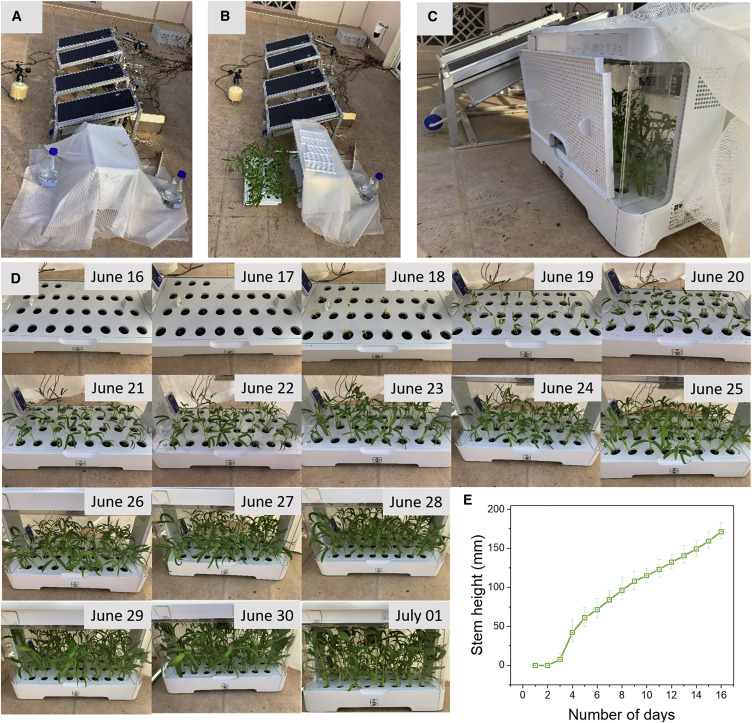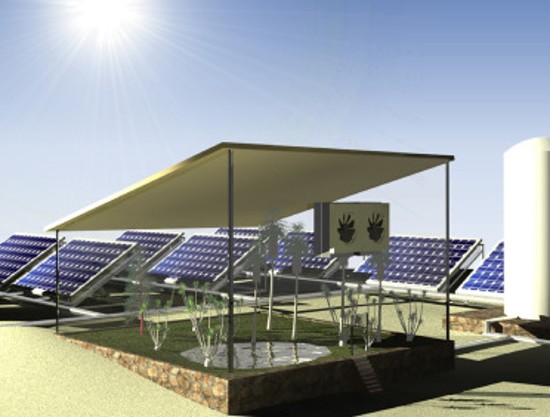In Saudi Arabia energy investments and research mostly focus on fossil fuels. But this month, researchers at King Abdullah University of Science and Technology (KAUST), came up with a solar panel design that not only produces electricity but also fresh water. It consists of a composite of solar panels and a lower layer containing a hydrogel that uses the excess heat from the upper to capture water from the surrounding air even in bone-dry desert conditions.
The researchers have called their invention, WEC2P, which is an acronym for the Water-Electricity-Crop-Co-Production system. It consists of an array of solar panels placed atop a downward-sloping box with a spout at the bottom. During the day as the panels generate electricity, the waste heat produced transfers to the underlayer of hydrogel which causes water within it to evaporate and condense on the underside. At night as temperatures drop, air circulates under the panel to produce further condensation with the water collected for storage.
In a June 2021 two-week test, a panel the size of a small desktop generated 1,519 watt-hours of electricity and produced 5.1 litres. The water collected was used to irrigate a planting chamber with 60 spinach seeds. The results of the experiment can be seen in the images appearing below.

A description of the technology was published this month in the open-access journal, Cell Reports Physical Science. The authors are Renyuan Li, Mengchun Wu, Sara Aleid, Chelin Zhang, Webin Wang, and Peng Wang, all affiliated with the Water Desalination and Reuse Center, in the Division of Biological and Environmental Science and Engineering at KAUST.
In the introduction to their paper they write:
“Stable supply of water, energy, and food are the three of the most essential and indispensable factors of modern life and are keys to universal achievements of the United Nation’s Sustainable Developments Goals by 2030.”
They continue noting an urgent need for “holistic approaches” to address the three human needs which impact the 2 billion globally who lack safe drinking water, the 800 million who have no access to electricity, and the up to 700 million who suffer from food insecurity and famine. They designed WEC2P to address all of these, but in particular, the immediate focus was on the 300 million living in North Africa, South Asia, the Middle East, and other arid and semi-arid climates.
Harvesting water from the air has been a pursuit of many. Back in 2019, I described work by researchers at the National University of Singapore, who were developing a hydrogel to capture water from the air, or ocean and release it as fresh. In another project in 2017, I wrote about collaborative work being done by teams at the Massachusetts Institute of Technology, UC Berkeley, the Lawrence Berkeley National Laboratory, and King Abdulaziz City for Science and Technology, in Riyadh, Saudi Arabia, who were developing a technology called MOF, an acronym for Metal-Organic Framework, a sponge-like honeycomb device that caused water vapour to condense within it even in very low-humidity environments.
But what sets this new invention apart from the others is its ability to address both energy self-sufficiency and freshwater production. The photovoltaic panels used by the KAUST team are off the shelf and produce average electrical conversion efficiencies of around 15%. But with the added hydrogel their efficiency improves by as much as 9% because the gel absorbs the heat and lowers the panels’ temperature. The condensation chamber beneath the panels includes a wick placed within a silicon tube which captures the water vapour and condensation rather than allowing any of it to evaporate.
To test the effectiveness of the device for crop production, the outfitted growing chamber beneath the solar panels was set up to provide cooling power should to installed fans if the air temperatures had exceeded 50 Celsius (122 Fahrenheit) which would have been detrimental to the test plants. But fortunately, throughout the June 16 to July 1, 2021 period of the test, daytime temperatures never exceeded that threshold.









